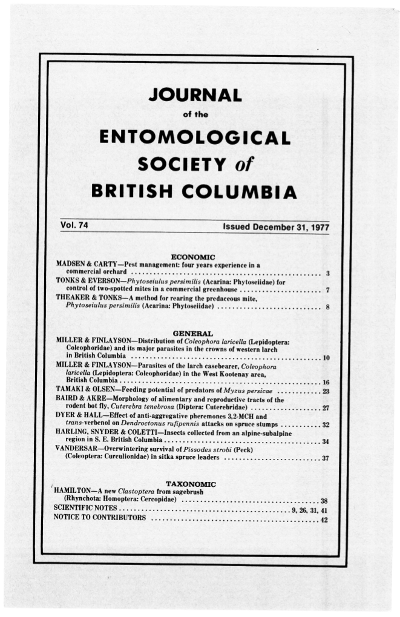Parasites of the larch casebearer, <i>Coleophora laricella</i> (Lepidoptera: Coleophoridae), in the West Kootenay area, British Columbia
Keywords:
larch casebearer, <i>Coleophora laricella</i>, <i>Dicladocerus</i> spp., <i>Spilochalcis albifroms</i>, <i>Mesopolobus</i> spp., parasite, Lepidoptera, ColeophoridaeAbstract
The parasite complex of the larch casebearer, <i>Coleophora laricella</i> (Hbn.), was investigated in the Kootenay area of British Columbia in 1973 and 1974. Forty-one species of hymenopterous parasites were obtained from rearings of almost 153,000 final-instar host larvae and pupae. In 1973 and 1974, 31 and 24 species, respectively, were reared, with 14 common to both years. Twenty-nine of these, in 24 genera, were confirmed as larch casebearer parasites by individual rearings and by reports in the literature. No parasites were obtained from eggs, needle-mining larvae, or third-instar case-bearing larvae. The highest total percentage parasitism was 17.7% in 1973 and 24.5% in 1974, both at Rossland. In Collection II the <i>Dicladocerus</i> spp. complex comprised 46.0% of the total parasitism in 1973. and 63.8% of the total in 1974: it was the most abundant at four of the eight collecting sites in 1973 and 13 of the 14 sites in 1974. <i>Spilochalcis albifroms</i> (Walsh) comprised 32.8% and 23.5% of the total parasitism in the years 1973 and 1974 respectively; it was most abundant at three collection sites in 1973 and at two in 1974. <i>Mesopolobus</i> sp. constituted 4.9% of the total in 1973 and 9.9% in 1974. Larch case bearer densities in the first collection in 1973 were highest at Fruitvale and Shoreacres with 150 and 130 cases per 100 fascicles respectively; in 1974, the highest host densities in the first collection were at Kootenay Bay and Fruitvale with 48 and 41 cases per 100 fascicles respectively.References
Andrews, R.J. and N.J. Geistlinger. 1969. Parasites of the larch casebearer, Coleophora laricella (Hbn.), in British Columbia (Lepidoptera: Coleophoridae). J. Entomol. Soc. Brit. Columb. 66:50-51.
Beacher, J.H. 1947. Studies of pistol case-bearer parasites. Ann. Ent. Soc. Am. 40:530-544.
Bousfield, W.E. and R.C. Lood. 1971. Impact of parasites on the larch casebearer in the Northern Region 1970. U.S.D.A. For. Serv. Rept. 71-4, Northern Region, Missoula, Mont.
Bousfield, W.E. and R.C. Lood. 1973. Parasites of the larch casebearer in Montana. Idaho, and Washington. Environ. Ent. 2:212-213.
Clausen, C.P. 1962. Entomophagous Insects. Hafner Publ. Co., New York.
Denton, R.E. 1972. Establishment of Agathis pumila (Ratz.) for control of larch casebearer, and notes on native parasitism and predation in Idaho. U.S.D.A. For. Serv. Res. Note INT-164, Intermt. For. and Range Exp. Stn.
Doner, M H. 1934. Observations on the biology of Microbracon pygmaeus (Prov.), an important parasite of Coleophora pruniella CL. Ann. Ent. Soc. Am. 27:435-442.
Doner, M.H. 1936. Hymenopterous parasites of Coleophora pruniella CL., and parasites recorded from other species of Coleophura. Ann. Ent. Soc. Am. 29:224-244.
Dowden, P.B. 1941. Parasites of the birch leaf-mining sawfly (Phyllotoma nemorata). U.S.D.A. Tech. Bull. 757.
Jasch, A. 1973. Populationsdynamik und Parasitenkomplex der Larchenminiermotte, Coleophora laricella Hbn., im naturlichen Verbreitungsgebiet der Europaischen Larche, Larix decidua Mill. Z. angew. Ent. 73:1-42.
Miller, G.E. and T. Finlayson. 1974. Native parasites of the larch case bearer. Coleophora laricella (Lepidoptera: Coleophoridae). in the west Kootenay area of British Columbia. J. Entomol. Soc. Brit. Columb. 71:14-21.
Morris, E. and J. Monts. 1972. Larch casebearer infestations in Nelson Forest District. 1972. Can. For. Serv., Forest Insect & Disease Surv. Pest Rept., Pacific Forest Research Centre, Victoria. B.C.
Quednau, F.W. 1970. Competition and cooperation between C. laricinellae and A. pumila on larch casebearer in Quebec. Can. Ent. 102:602-612.
Ryan, R.B., W.E. Bousfield. R.E. Denton. R.L. Johnsey. L.F. Pettinger, and R.F. Schmitz. 1975. Additional releases of larch casebearer parasites for biological control in the western United States. U.S.D.A. For. Serv. Res. Note PNW-242.
Ryan, R.B., W.E. Bousfield, C.W. Johanningmeier, G.B. Parsons, R.F. Schmitz, and L.J. Theroux. 1977. Releases of recently imported larch case bearer parasites for biological control in the western United States, including relocations of Agathis pumila. U.S.D.A. For. Serv. Res. Note PNW-290.
Ryan, R.B., W.E. Bousfield, G.E. Miller, and T. Finlayson. 1974. Presence of Chrysocharis laricinellae, a parasite of the larch casebearer, in the Pacific Northwest. J. Econ. Ent. 67:805.
Ryan, R.B. and R.E. Denton. 1973. Initial releases of Chrysocharis laricinellae and Dicladocerus westwoodii for biological control of the larch casebearer in the western United States. U.S.D.A. For Serv. Res. Note PNW-200.
Sloan, N.F. 1965. Biotic factors affecting populations of the larch casebearer Coleophora laricella Hbn. in Wisconsin. Ph.D. Thesis, Univ. of Wisconsin, Madison. Wisc.
Turnbull, A L. and D.A. Chant. 1961. The practice and theory of biological control of insects in Canada. Can. J. Zool. 39:697-753.
Webb. F.E. 1953. An ecological study of the larch casebearer. Coleophora laricella Hbn. (Lepidoptera: Coleophoridae). Ph.D. Thesis. Univ. of Michigan. Ann Arbor, Mich.
Yoshimoto, C.M. 1976. Revision of the genus Dicladocerus (Eulophidae: Chalcidoidea) of America north of Mexico, with particular reference to species attacking larch casebearer (Lepidoptera: Co leophoridae). Can. Ent. l08:1173-1206.
Downloads
Published
Issue
Section
License
Authors who publish with the Journal of the Entomological Society of British Columbia agree to the following terms:
-Authors retain copyright and grant the journal right of first publication with the work simultaneously licensed under a Creative Commons Attribution License that allows others to share the work with an acknowledgement of the work's authorship and initial publication in this journal.
-Authors are able to enter into separate, additional contractual arrangements for the non-exclusive distribution of the journal's published version of the work (e.g., post it to an institutional repository or publish it in a book), with an acknowledgement of its initial publication in this journal.
-Authors are permitted and encouraged to post their work online (e.g., in institutional repositories or on their website) prior to and during the submission process, as it can lead to productive exchanges, as well as earlier and greater citation of published work (See The Effect of Open Access).


